MGT202 Assessment 1: Leaders and Learning Essay Analysis
VerifiedAdded on 2023/06/07
|6
|1991
|349
Essay
AI Summary
This essay, submitted as part of MGT202, delves into the multifaceted nature of leadership, drawing upon John C. Maxwell's assertion that a leader 'knows the way, goes the way, and shows the way.' It explores these three dimensions through the framework of organisational learning theories. The essay examines how leaders utilize vision and strategy (knowing the way), overcome obstacles and take initiative (going the way), and provide clarity and guidance to their followers (showing the way). It incorporates different leadership styles such as Diplomat, Steward, Idealist, and Pragmatist, substantiated by real-world examples, including the example of Jesus Christ as the ultimate leader. The paper further discusses the importance of clear vision, effective communication, and risk-taking in achieving organisational success, supported by a minimum of 10 academic sources. The essay aims to provide a comprehensive understanding of effective leadership by analysing the application of organisational learning principles and their impact on leadership practices.
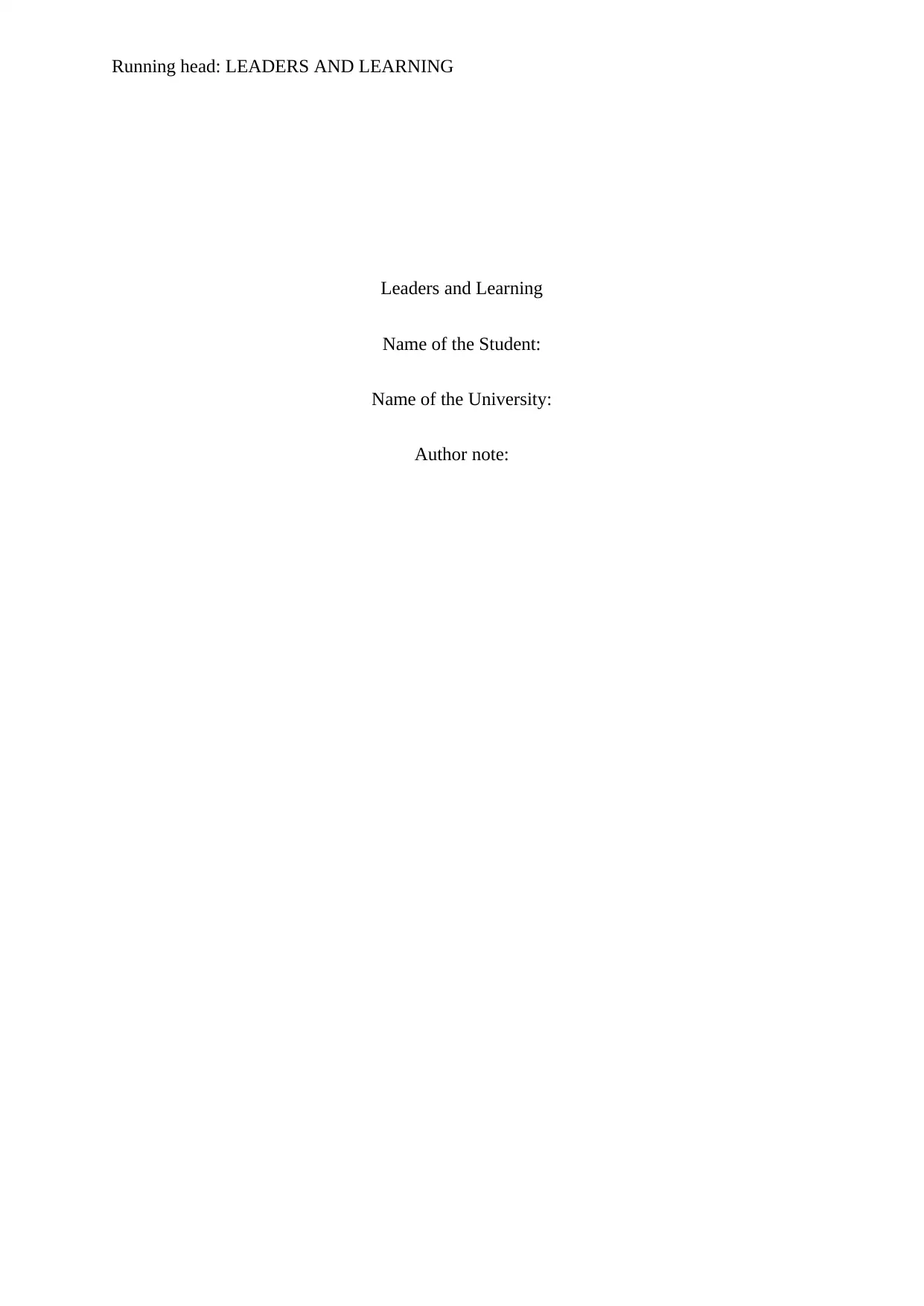
Running head: LEADERS AND LEARNING
Leaders and Learning
Name of the Student:
Name of the University:
Author note:
Leaders and Learning
Name of the Student:
Name of the University:
Author note:
Paraphrase This Document
Need a fresh take? Get an instant paraphrase of this document with our AI Paraphraser
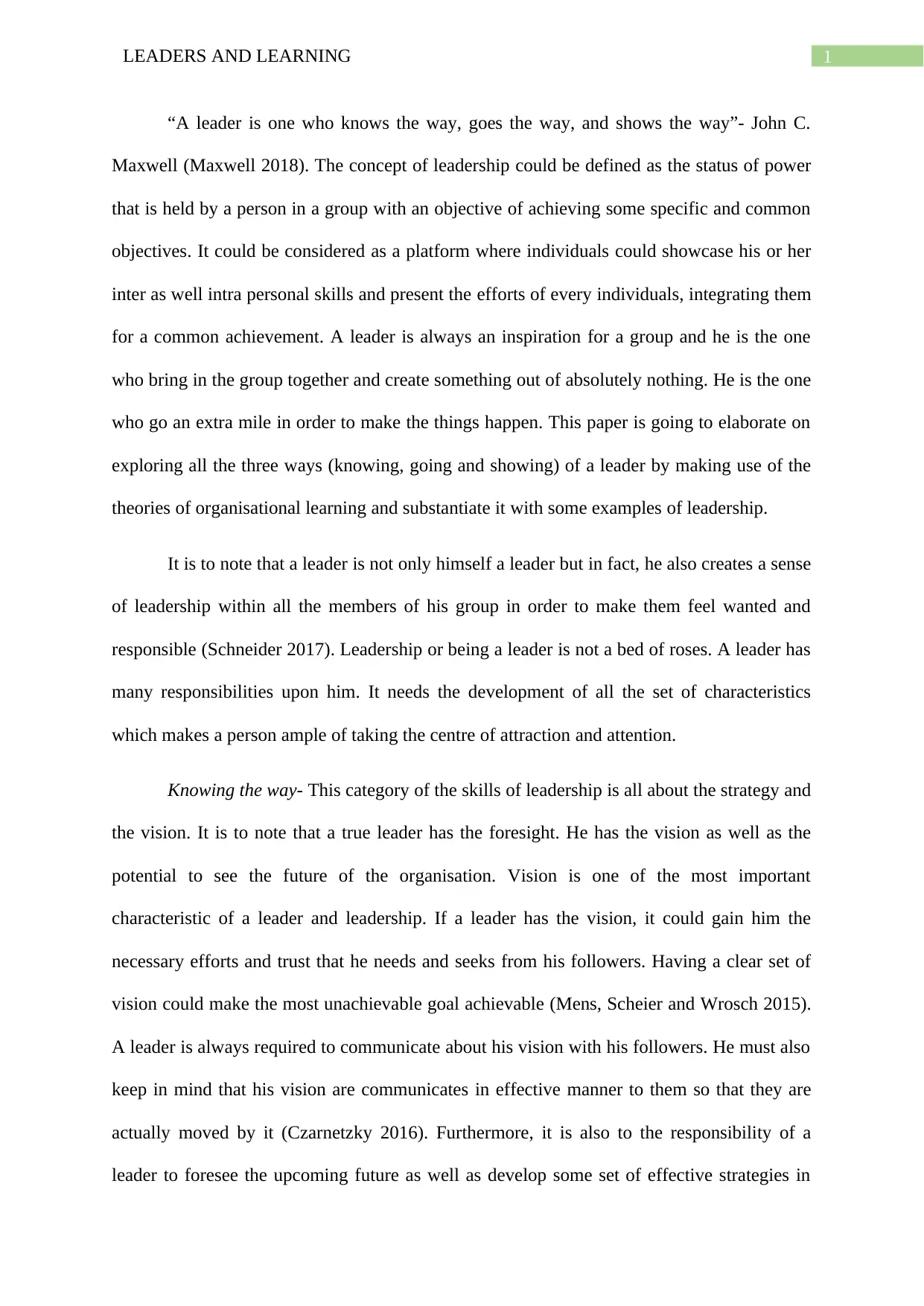
1LEADERS AND LEARNING
“A leader is one who knows the way, goes the way, and shows the way”- John C.
Maxwell (Maxwell 2018). The concept of leadership could be defined as the status of power
that is held by a person in a group with an objective of achieving some specific and common
objectives. It could be considered as a platform where individuals could showcase his or her
inter as well intra personal skills and present the efforts of every individuals, integrating them
for a common achievement. A leader is always an inspiration for a group and he is the one
who bring in the group together and create something out of absolutely nothing. He is the one
who go an extra mile in order to make the things happen. This paper is going to elaborate on
exploring all the three ways (knowing, going and showing) of a leader by making use of the
theories of organisational learning and substantiate it with some examples of leadership.
It is to note that a leader is not only himself a leader but in fact, he also creates a sense
of leadership within all the members of his group in order to make them feel wanted and
responsible (Schneider 2017). Leadership or being a leader is not a bed of roses. A leader has
many responsibilities upon him. It needs the development of all the set of characteristics
which makes a person ample of taking the centre of attraction and attention.
Knowing the way- This category of the skills of leadership is all about the strategy and
the vision. It is to note that a true leader has the foresight. He has the vision as well as the
potential to see the future of the organisation. Vision is one of the most important
characteristic of a leader and leadership. If a leader has the vision, it could gain him the
necessary efforts and trust that he needs and seeks from his followers. Having a clear set of
vision could make the most unachievable goal achievable (Mens, Scheier and Wrosch 2015).
A leader is always required to communicate about his vision with his followers. He must also
keep in mind that his vision are communicates in effective manner to them so that they are
actually moved by it (Czarnetzky 2016). Furthermore, it is also to the responsibility of a
leader to foresee the upcoming future as well as develop some set of effective strategies in
“A leader is one who knows the way, goes the way, and shows the way”- John C.
Maxwell (Maxwell 2018). The concept of leadership could be defined as the status of power
that is held by a person in a group with an objective of achieving some specific and common
objectives. It could be considered as a platform where individuals could showcase his or her
inter as well intra personal skills and present the efforts of every individuals, integrating them
for a common achievement. A leader is always an inspiration for a group and he is the one
who bring in the group together and create something out of absolutely nothing. He is the one
who go an extra mile in order to make the things happen. This paper is going to elaborate on
exploring all the three ways (knowing, going and showing) of a leader by making use of the
theories of organisational learning and substantiate it with some examples of leadership.
It is to note that a leader is not only himself a leader but in fact, he also creates a sense
of leadership within all the members of his group in order to make them feel wanted and
responsible (Schneider 2017). Leadership or being a leader is not a bed of roses. A leader has
many responsibilities upon him. It needs the development of all the set of characteristics
which makes a person ample of taking the centre of attraction and attention.
Knowing the way- This category of the skills of leadership is all about the strategy and
the vision. It is to note that a true leader has the foresight. He has the vision as well as the
potential to see the future of the organisation. Vision is one of the most important
characteristic of a leader and leadership. If a leader has the vision, it could gain him the
necessary efforts and trust that he needs and seeks from his followers. Having a clear set of
vision could make the most unachievable goal achievable (Mens, Scheier and Wrosch 2015).
A leader is always required to communicate about his vision with his followers. He must also
keep in mind that his vision are communicates in effective manner to them so that they are
actually moved by it (Czarnetzky 2016). Furthermore, it is also to the responsibility of a
leader to foresee the upcoming future as well as develop some set of effective strategies in
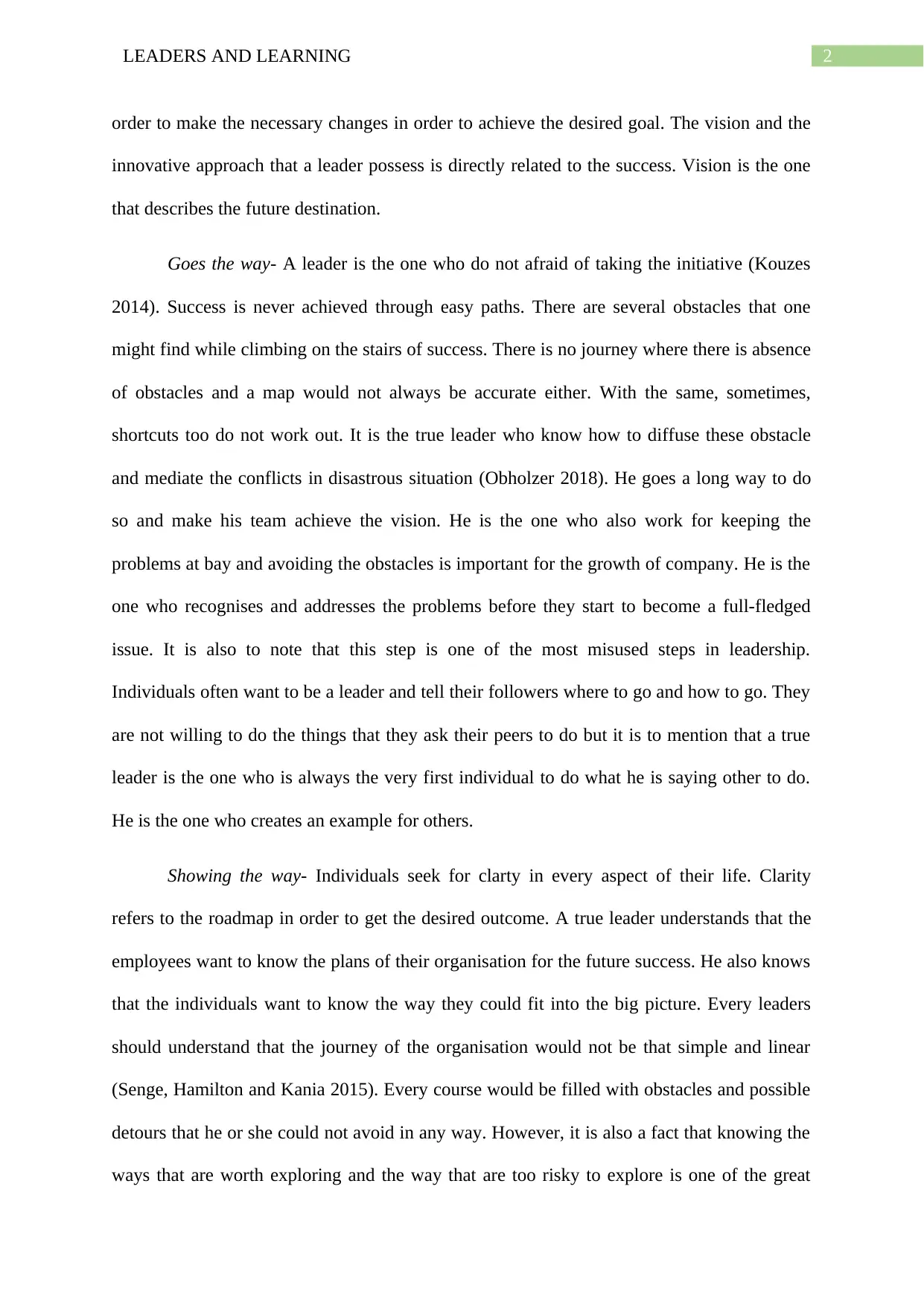
2LEADERS AND LEARNING
order to make the necessary changes in order to achieve the desired goal. The vision and the
innovative approach that a leader possess is directly related to the success. Vision is the one
that describes the future destination.
Goes the way- A leader is the one who do not afraid of taking the initiative (Kouzes
2014). Success is never achieved through easy paths. There are several obstacles that one
might find while climbing on the stairs of success. There is no journey where there is absence
of obstacles and a map would not always be accurate either. With the same, sometimes,
shortcuts too do not work out. It is the true leader who know how to diffuse these obstacle
and mediate the conflicts in disastrous situation (Obholzer 2018). He goes a long way to do
so and make his team achieve the vision. He is the one who also work for keeping the
problems at bay and avoiding the obstacles is important for the growth of company. He is the
one who recognises and addresses the problems before they start to become a full-fledged
issue. It is also to note that this step is one of the most misused steps in leadership.
Individuals often want to be a leader and tell their followers where to go and how to go. They
are not willing to do the things that they ask their peers to do but it is to mention that a true
leader is the one who is always the very first individual to do what he is saying other to do.
He is the one who creates an example for others.
Showing the way- Individuals seek for clarty in every aspect of their life. Clarity
refers to the roadmap in order to get the desired outcome. A true leader understands that the
employees want to know the plans of their organisation for the future success. He also knows
that the individuals want to know the way they could fit into the big picture. Every leaders
should understand that the journey of the organisation would not be that simple and linear
(Senge, Hamilton and Kania 2015). Every course would be filled with obstacles and possible
detours that he or she could not avoid in any way. However, it is also a fact that knowing the
ways that are worth exploring and the way that are too risky to explore is one of the great
order to make the necessary changes in order to achieve the desired goal. The vision and the
innovative approach that a leader possess is directly related to the success. Vision is the one
that describes the future destination.
Goes the way- A leader is the one who do not afraid of taking the initiative (Kouzes
2014). Success is never achieved through easy paths. There are several obstacles that one
might find while climbing on the stairs of success. There is no journey where there is absence
of obstacles and a map would not always be accurate either. With the same, sometimes,
shortcuts too do not work out. It is the true leader who know how to diffuse these obstacle
and mediate the conflicts in disastrous situation (Obholzer 2018). He goes a long way to do
so and make his team achieve the vision. He is the one who also work for keeping the
problems at bay and avoiding the obstacles is important for the growth of company. He is the
one who recognises and addresses the problems before they start to become a full-fledged
issue. It is also to note that this step is one of the most misused steps in leadership.
Individuals often want to be a leader and tell their followers where to go and how to go. They
are not willing to do the things that they ask their peers to do but it is to mention that a true
leader is the one who is always the very first individual to do what he is saying other to do.
He is the one who creates an example for others.
Showing the way- Individuals seek for clarty in every aspect of their life. Clarity
refers to the roadmap in order to get the desired outcome. A true leader understands that the
employees want to know the plans of their organisation for the future success. He also knows
that the individuals want to know the way they could fit into the big picture. Every leaders
should understand that the journey of the organisation would not be that simple and linear
(Senge, Hamilton and Kania 2015). Every course would be filled with obstacles and possible
detours that he or she could not avoid in any way. However, it is also a fact that knowing the
ways that are worth exploring and the way that are too risky to explore is one of the great
⊘ This is a preview!⊘
Do you want full access?
Subscribe today to unlock all pages.

Trusted by 1+ million students worldwide
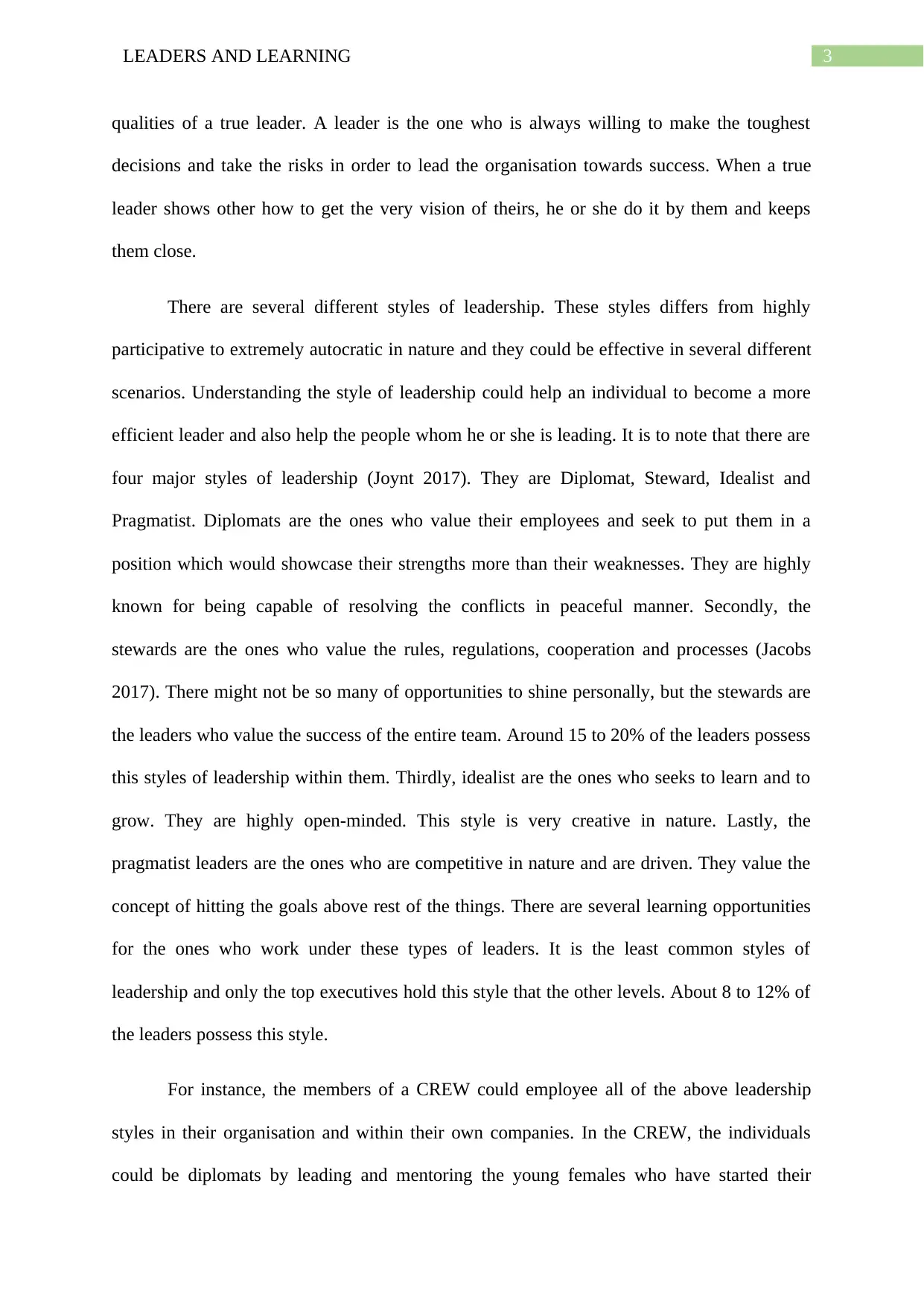
3LEADERS AND LEARNING
qualities of a true leader. A leader is the one who is always willing to make the toughest
decisions and take the risks in order to lead the organisation towards success. When a true
leader shows other how to get the very vision of theirs, he or she do it by them and keeps
them close.
There are several different styles of leadership. These styles differs from highly
participative to extremely autocratic in nature and they could be effective in several different
scenarios. Understanding the style of leadership could help an individual to become a more
efficient leader and also help the people whom he or she is leading. It is to note that there are
four major styles of leadership (Joynt 2017). They are Diplomat, Steward, Idealist and
Pragmatist. Diplomats are the ones who value their employees and seek to put them in a
position which would showcase their strengths more than their weaknesses. They are highly
known for being capable of resolving the conflicts in peaceful manner. Secondly, the
stewards are the ones who value the rules, regulations, cooperation and processes (Jacobs
2017). There might not be so many of opportunities to shine personally, but the stewards are
the leaders who value the success of the entire team. Around 15 to 20% of the leaders possess
this styles of leadership within them. Thirdly, idealist are the ones who seeks to learn and to
grow. They are highly open-minded. This style is very creative in nature. Lastly, the
pragmatist leaders are the ones who are competitive in nature and are driven. They value the
concept of hitting the goals above rest of the things. There are several learning opportunities
for the ones who work under these types of leaders. It is the least common styles of
leadership and only the top executives hold this style that the other levels. About 8 to 12% of
the leaders possess this style.
For instance, the members of a CREW could employee all of the above leadership
styles in their organisation and within their own companies. In the CREW, the individuals
could be diplomats by leading and mentoring the young females who have started their
qualities of a true leader. A leader is the one who is always willing to make the toughest
decisions and take the risks in order to lead the organisation towards success. When a true
leader shows other how to get the very vision of theirs, he or she do it by them and keeps
them close.
There are several different styles of leadership. These styles differs from highly
participative to extremely autocratic in nature and they could be effective in several different
scenarios. Understanding the style of leadership could help an individual to become a more
efficient leader and also help the people whom he or she is leading. It is to note that there are
four major styles of leadership (Joynt 2017). They are Diplomat, Steward, Idealist and
Pragmatist. Diplomats are the ones who value their employees and seek to put them in a
position which would showcase their strengths more than their weaknesses. They are highly
known for being capable of resolving the conflicts in peaceful manner. Secondly, the
stewards are the ones who value the rules, regulations, cooperation and processes (Jacobs
2017). There might not be so many of opportunities to shine personally, but the stewards are
the leaders who value the success of the entire team. Around 15 to 20% of the leaders possess
this styles of leadership within them. Thirdly, idealist are the ones who seeks to learn and to
grow. They are highly open-minded. This style is very creative in nature. Lastly, the
pragmatist leaders are the ones who are competitive in nature and are driven. They value the
concept of hitting the goals above rest of the things. There are several learning opportunities
for the ones who work under these types of leaders. It is the least common styles of
leadership and only the top executives hold this style that the other levels. About 8 to 12% of
the leaders possess this style.
For instance, the members of a CREW could employee all of the above leadership
styles in their organisation and within their own companies. In the CREW, the individuals
could be diplomats by leading and mentoring the young females who have started their
Paraphrase This Document
Need a fresh take? Get an instant paraphrase of this document with our AI Paraphraser
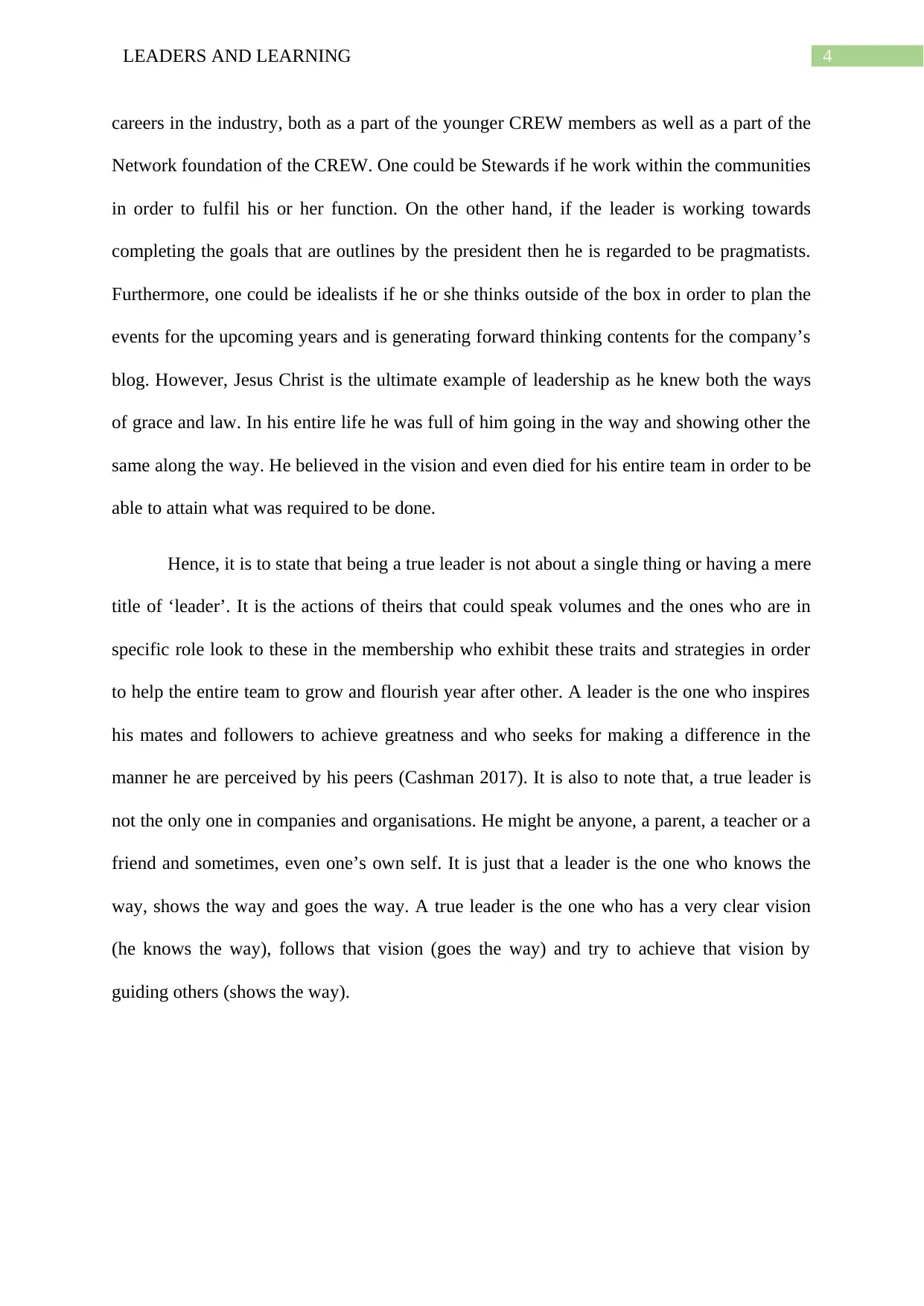
4LEADERS AND LEARNING
careers in the industry, both as a part of the younger CREW members as well as a part of the
Network foundation of the CREW. One could be Stewards if he work within the communities
in order to fulfil his or her function. On the other hand, if the leader is working towards
completing the goals that are outlines by the president then he is regarded to be pragmatists.
Furthermore, one could be idealists if he or she thinks outside of the box in order to plan the
events for the upcoming years and is generating forward thinking contents for the company’s
blog. However, Jesus Christ is the ultimate example of leadership as he knew both the ways
of grace and law. In his entire life he was full of him going in the way and showing other the
same along the way. He believed in the vision and even died for his entire team in order to be
able to attain what was required to be done.
Hence, it is to state that being a true leader is not about a single thing or having a mere
title of ‘leader’. It is the actions of theirs that could speak volumes and the ones who are in
specific role look to these in the membership who exhibit these traits and strategies in order
to help the entire team to grow and flourish year after other. A leader is the one who inspires
his mates and followers to achieve greatness and who seeks for making a difference in the
manner he are perceived by his peers (Cashman 2017). It is also to note that, a true leader is
not the only one in companies and organisations. He might be anyone, a parent, a teacher or a
friend and sometimes, even one’s own self. It is just that a leader is the one who knows the
way, shows the way and goes the way. A true leader is the one who has a very clear vision
(he knows the way), follows that vision (goes the way) and try to achieve that vision by
guiding others (shows the way).
careers in the industry, both as a part of the younger CREW members as well as a part of the
Network foundation of the CREW. One could be Stewards if he work within the communities
in order to fulfil his or her function. On the other hand, if the leader is working towards
completing the goals that are outlines by the president then he is regarded to be pragmatists.
Furthermore, one could be idealists if he or she thinks outside of the box in order to plan the
events for the upcoming years and is generating forward thinking contents for the company’s
blog. However, Jesus Christ is the ultimate example of leadership as he knew both the ways
of grace and law. In his entire life he was full of him going in the way and showing other the
same along the way. He believed in the vision and even died for his entire team in order to be
able to attain what was required to be done.
Hence, it is to state that being a true leader is not about a single thing or having a mere
title of ‘leader’. It is the actions of theirs that could speak volumes and the ones who are in
specific role look to these in the membership who exhibit these traits and strategies in order
to help the entire team to grow and flourish year after other. A leader is the one who inspires
his mates and followers to achieve greatness and who seeks for making a difference in the
manner he are perceived by his peers (Cashman 2017). It is also to note that, a true leader is
not the only one in companies and organisations. He might be anyone, a parent, a teacher or a
friend and sometimes, even one’s own self. It is just that a leader is the one who knows the
way, shows the way and goes the way. A true leader is the one who has a very clear vision
(he knows the way), follows that vision (goes the way) and try to achieve that vision by
guiding others (shows the way).
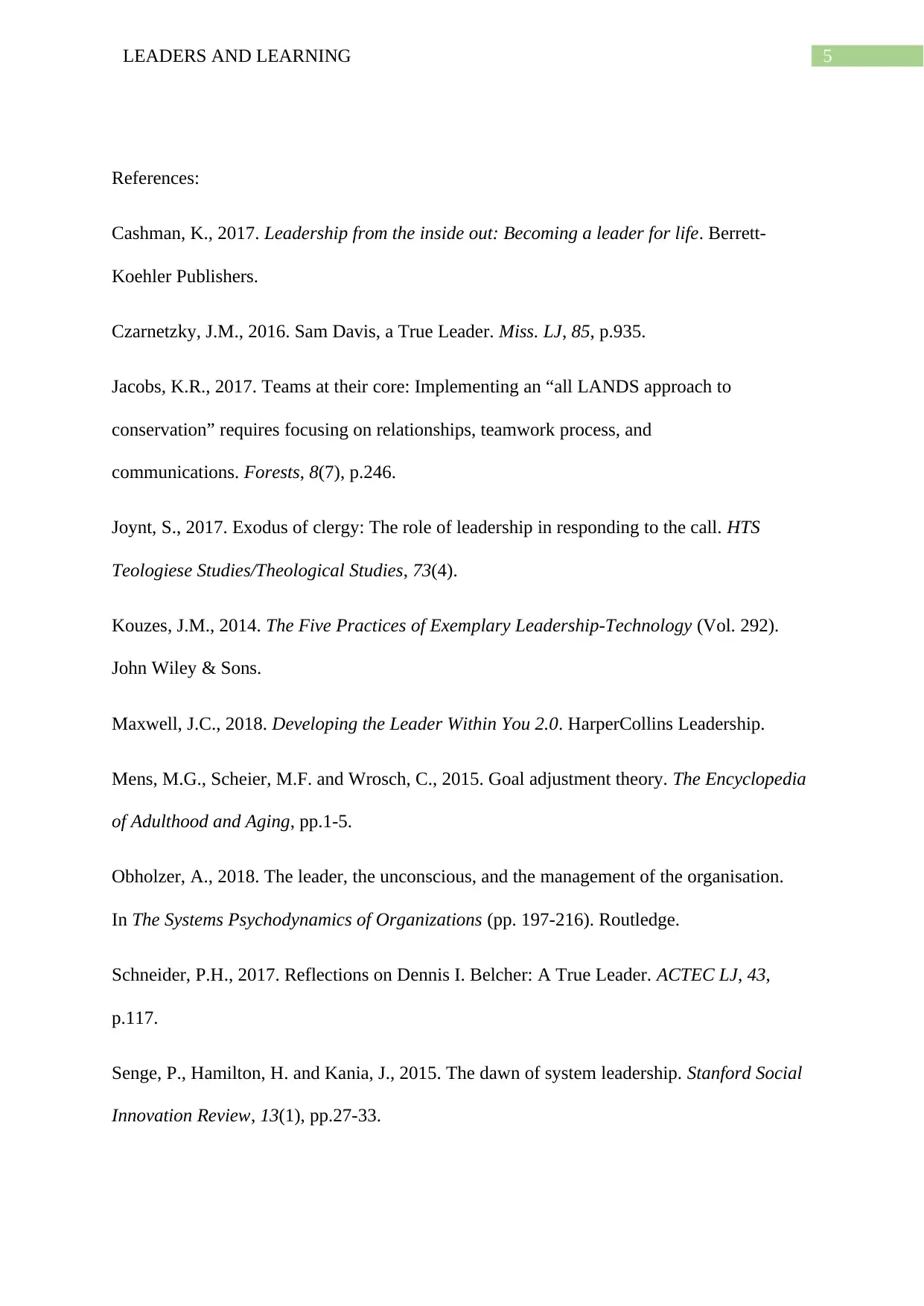
5LEADERS AND LEARNING
References:
Cashman, K., 2017. Leadership from the inside out: Becoming a leader for life. Berrett-
Koehler Publishers.
Czarnetzky, J.M., 2016. Sam Davis, a True Leader. Miss. LJ, 85, p.935.
Jacobs, K.R., 2017. Teams at their core: Implementing an “all LANDS approach to
conservation” requires focusing on relationships, teamwork process, and
communications. Forests, 8(7), p.246.
Joynt, S., 2017. Exodus of clergy: The role of leadership in responding to the call. HTS
Teologiese Studies/Theological Studies, 73(4).
Kouzes, J.M., 2014. The Five Practices of Exemplary Leadership-Technology (Vol. 292).
John Wiley & Sons.
Maxwell, J.C., 2018. Developing the Leader Within You 2.0. HarperCollins Leadership.
Mens, M.G., Scheier, M.F. and Wrosch, C., 2015. Goal adjustment theory. The Encyclopedia
of Adulthood and Aging, pp.1-5.
Obholzer, A., 2018. The leader, the unconscious, and the management of the organisation.
In The Systems Psychodynamics of Organizations (pp. 197-216). Routledge.
Schneider, P.H., 2017. Reflections on Dennis I. Belcher: A True Leader. ACTEC LJ, 43,
p.117.
Senge, P., Hamilton, H. and Kania, J., 2015. The dawn of system leadership. Stanford Social
Innovation Review, 13(1), pp.27-33.
References:
Cashman, K., 2017. Leadership from the inside out: Becoming a leader for life. Berrett-
Koehler Publishers.
Czarnetzky, J.M., 2016. Sam Davis, a True Leader. Miss. LJ, 85, p.935.
Jacobs, K.R., 2017. Teams at their core: Implementing an “all LANDS approach to
conservation” requires focusing on relationships, teamwork process, and
communications. Forests, 8(7), p.246.
Joynt, S., 2017. Exodus of clergy: The role of leadership in responding to the call. HTS
Teologiese Studies/Theological Studies, 73(4).
Kouzes, J.M., 2014. The Five Practices of Exemplary Leadership-Technology (Vol. 292).
John Wiley & Sons.
Maxwell, J.C., 2018. Developing the Leader Within You 2.0. HarperCollins Leadership.
Mens, M.G., Scheier, M.F. and Wrosch, C., 2015. Goal adjustment theory. The Encyclopedia
of Adulthood and Aging, pp.1-5.
Obholzer, A., 2018. The leader, the unconscious, and the management of the organisation.
In The Systems Psychodynamics of Organizations (pp. 197-216). Routledge.
Schneider, P.H., 2017. Reflections on Dennis I. Belcher: A True Leader. ACTEC LJ, 43,
p.117.
Senge, P., Hamilton, H. and Kania, J., 2015. The dawn of system leadership. Stanford Social
Innovation Review, 13(1), pp.27-33.
⊘ This is a preview!⊘
Do you want full access?
Subscribe today to unlock all pages.

Trusted by 1+ million students worldwide
1 out of 6
Related Documents
Your All-in-One AI-Powered Toolkit for Academic Success.
+13062052269
info@desklib.com
Available 24*7 on WhatsApp / Email
![[object Object]](/_next/static/media/star-bottom.7253800d.svg)
Unlock your academic potential
Copyright © 2020–2025 A2Z Services. All Rights Reserved. Developed and managed by ZUCOL.





